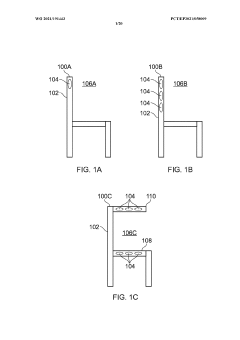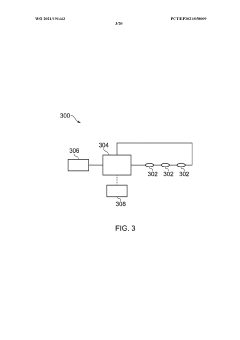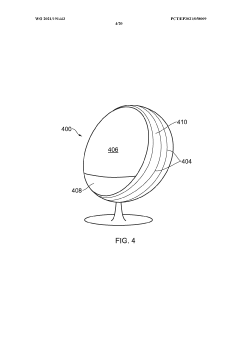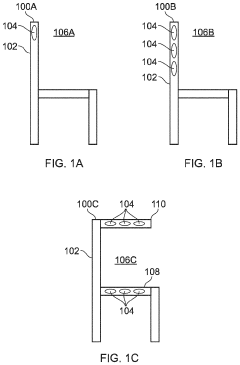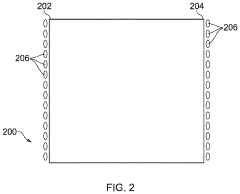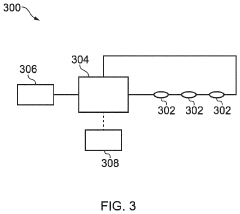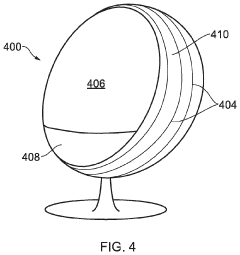Schumann Resonance and Its Role in Atmospheric Science
Schumann Resonance Background and Objectives
Schumann resonance, discovered by physicist Winfried Otto Schumann in 1952, is a set of spectrum peaks in the extremely low frequency (ELF) portion of the Earth's electromagnetic field spectrum. This phenomenon occurs due to the resonance of electromagnetic waves within the cavity formed between the Earth's surface and the ionosphere. The fundamental frequency of Schumann resonance is approximately 7.83 Hz, with harmonics at higher frequencies.
The study of Schumann resonance has evolved significantly since its discovery, becoming an essential tool in atmospheric science and geophysics. Initially, it was primarily of interest to researchers in the field of radio wave propagation. However, as our understanding of the Earth's electromagnetic environment has grown, so too has the importance of Schumann resonance in various scientific disciplines.
The primary objective of studying Schumann resonance is to gain deeper insights into the Earth's electromagnetic environment and its interactions with the atmosphere, ionosphere, and magnetosphere. This research aims to enhance our understanding of global atmospheric dynamics, climate change, and space weather phenomena. By monitoring variations in Schumann resonance parameters, scientists can detect and analyze changes in the Earth-ionosphere cavity, which may be influenced by various factors such as solar activity, lightning activity, and even human-induced electromagnetic pollution.
Another crucial goal of Schumann resonance research is to develop more accurate models of the Earth's electromagnetic environment. These models are essential for improving our ability to predict and mitigate the effects of space weather events on technological systems, such as satellite communications and power grids. Additionally, studying Schumann resonance can provide valuable information about global lightning activity, which is closely linked to atmospheric convection and climate patterns.
In recent years, there has been growing interest in exploring potential applications of Schumann resonance in fields beyond atmospheric science. For instance, some researchers are investigating its possible effects on human health and biological systems, although this remains a controversial area of study. Furthermore, there is ongoing research into utilizing Schumann resonance measurements for earthquake prediction and monitoring of other geophysical phenomena.
As technology advances, the methods for detecting and analyzing Schumann resonance continue to improve. This progress has led to more precise measurements and a better understanding of the subtle variations in the Earth's electromagnetic environment. The development of global networks of Schumann resonance monitoring stations has enabled researchers to study this phenomenon on a planetary scale, providing unprecedented insights into the Earth's electromagnetic behavior.
Atmospheric Science Applications and Demand
The Schumann resonance, a set of spectral peaks in the extremely low frequency (ELF) portion of the Earth's electromagnetic field spectrum, has garnered significant attention in atmospheric science due to its potential applications and implications for various fields. The demand for research and applications related to Schumann resonance has been steadily increasing, driven by its relevance to global climate monitoring, weather prediction, and space weather studies.
In the realm of global climate monitoring, Schumann resonance observations offer a unique perspective on large-scale atmospheric dynamics. Scientists have recognized the potential of these resonances as indicators of global temperature changes and variations in the Earth's electric circuit. This has led to an increased demand for long-term monitoring stations and data analysis techniques to extract meaningful climate-related information from Schumann resonance measurements.
Weather prediction models have also begun to incorporate Schumann resonance data to improve forecasting accuracy. The resonance's sensitivity to lightning activity and global thunderstorm distribution provides valuable input for understanding atmospheric convection patterns and severe weather development. Meteorological agencies and research institutions are increasingly investing in Schumann resonance monitoring equipment to enhance their predictive capabilities.
Space weather studies represent another growing area of demand for Schumann resonance applications. The resonance's interaction with the ionosphere makes it a valuable tool for monitoring solar-terrestrial interactions and their effects on Earth's upper atmosphere. Space agencies and satellite operators are particularly interested in using Schumann resonance data to improve their understanding of ionospheric disturbances and their potential impact on communication systems.
The telecommunications industry has also shown interest in Schumann resonance research, particularly in its potential to provide insights into natural electromagnetic noise sources that can affect signal propagation. This has led to collaborations between atmospheric scientists and telecommunications engineers to develop more robust communication systems.
Environmental monitoring represents another emerging application area for Schumann resonance. Researchers are exploring its potential as a tool for detecting seismic activity, monitoring forest health, and even tracking changes in the Earth's water cycle. These diverse applications have sparked interest from environmental agencies and conservation organizations, further driving demand for Schumann resonance research and monitoring technologies.
As the potential applications of Schumann resonance continue to expand, there is a growing need for interdisciplinary collaboration and specialized training programs. Universities and research institutions are responding to this demand by developing courses and research programs that bridge atmospheric science, physics, and electrical engineering to advance Schumann resonance studies and applications.
Current State and Challenges in SR Detection
The detection of Schumann Resonances (SR) has made significant progress in recent years, but several challenges remain. Currently, SR detection primarily relies on extremely low frequency (ELF) receivers, which measure the electromagnetic field variations in the Earth-ionosphere cavity. These receivers typically consist of sensitive magnetometers and electric field sensors, often deployed in remote locations to minimize anthropogenic electromagnetic interference.
One of the main challenges in SR detection is the low signal-to-noise ratio. The SR signals are extremely weak, with amplitudes in the range of picoteslas for magnetic fields and microvolts per meter for electric fields. This necessitates highly sensitive equipment and sophisticated signal processing techniques to extract meaningful data from background noise. Additionally, natural and artificial electromagnetic disturbances can significantly impact the quality of SR measurements.
The global distribution of SR detection stations remains limited, with only a handful of dedicated observatories worldwide. This sparse network hampers our ability to conduct comprehensive global studies of SR phenomena and their variations. Expanding the network of SR detection stations, particularly in underrepresented regions, is crucial for improving our understanding of global atmospheric processes and potential climate change indicators.
Another significant challenge lies in the standardization of SR detection methods and data analysis techniques. Different research groups often employ varying methodologies, making it difficult to compare results across studies. Establishing standardized protocols for SR detection, data processing, and analysis would greatly enhance the reliability and comparability of SR measurements globally.
The interpretation of SR data presents its own set of challenges. While SR measurements provide valuable insights into global lightning activity and ionospheric conditions, correlating these measurements with specific atmospheric phenomena or climate patterns requires complex modeling and analysis. Improving our understanding of the relationship between SR parameters and various atmospheric and ionospheric processes remains an active area of research.
Technological limitations also pose challenges in SR detection. Current equipment often suffers from drift and calibration issues, particularly over long-term measurements. Developing more stable and reliable sensors, as well as improving calibration techniques, is essential for enhancing the accuracy and long-term consistency of SR measurements.
Lastly, the integration of SR data with other atmospheric and space weather observations remains a challenge. Combining SR measurements with data from other sources, such as satellite imagery, radar systems, and ground-based atmospheric sensors, could provide a more comprehensive understanding of global atmospheric dynamics. However, this integration requires advanced data fusion techniques and interdisciplinary collaboration, which are still in the early stages of development.
Existing SR Monitoring Solutions
01 Schumann Resonance Generators
Devices designed to generate or simulate Schumann resonance frequencies for various applications, including health and wellness. These generators aim to replicate the natural electromagnetic frequencies found in the Earth's atmosphere, which are believed to have beneficial effects on human physiology and well-being.- Schumann Resonance Generators: Devices designed to generate or simulate Schumann resonance frequencies for various applications, including health and wellness. These generators aim to replicate the natural electromagnetic frequencies of the Earth's atmosphere, which are believed to have beneficial effects on human physiology and well-being.
- Therapeutic Applications of Schumann Resonance: Utilization of Schumann resonance in therapeutic devices and methods for improving health, reducing stress, and enhancing overall well-being. These applications often involve exposure to Schumann resonance frequencies through various means, such as wearable devices or environmental systems.
- Schumann Resonance Measurement and Detection: Systems and methods for measuring and detecting Schumann resonance frequencies in the environment. These technologies may be used for scientific research, environmental monitoring, or as part of larger systems that incorporate Schumann resonance data.
- Integration of Schumann Resonance in Consumer Products: Incorporation of Schumann resonance technology into various consumer products, such as furniture, bedding, or personal accessories. These products aim to provide the benefits of Schumann resonance exposure in everyday life settings.
- Schumann Resonance in Environmental Systems: Application of Schumann resonance principles in environmental control systems, such as air purifiers, water treatment devices, or agricultural technologies. These systems may use Schumann resonance to enhance their effectiveness or provide additional benefits.
02 Therapeutic Applications of Schumann Resonance
Utilization of Schumann resonance in therapeutic devices and methods for improving health, reducing stress, and enhancing overall well-being. These applications often involve exposure to Schumann resonance frequencies through various means, such as wearable devices or environmental systems.Expand Specific Solutions03 Schumann Resonance Measurement and Detection
Systems and methods for measuring and detecting Schumann resonance frequencies in the environment. These technologies are used for scientific research, environmental monitoring, and potential applications in forecasting natural phenomena or assessing electromagnetic pollution.Expand Specific Solutions04 Integration of Schumann Resonance in Consumer Products
Incorporation of Schumann resonance technology into various consumer products, such as furniture, bedding, and personal accessories. These products aim to create a harmonious electromagnetic environment for users by emitting or amplifying Schumann resonance frequencies.Expand Specific Solutions05 Schumann Resonance in Agricultural Applications
Use of Schumann resonance frequencies in agricultural settings to potentially improve crop growth, soil health, and overall farm productivity. This includes devices and methods that apply Schumann resonance to plants, seeds, or agricultural environments.Expand Specific Solutions
Key Players in SR Research and Instrumentation
The Schumann Resonance field is in a mature stage of development, with ongoing research and applications in atmospheric science. The market size is relatively niche but growing, driven by increased interest in climate monitoring and space weather prediction. Technologically, it's well-established, with companies like The Boeing Co. and BAE Systems Information & Electronic Sys Integration, Inc. applying it in aerospace and defense. Research institutions such as Xi'an University of Technology and the University of Bern are advancing the fundamental understanding. Vaisala Oyj leads in atmospheric measurement instruments, while Ramot at Tel Aviv University Ltd. and Brookhaven Science Associates LLC contribute to cutting-edge research. The Korea Research Institute of Standards & Science is enhancing measurement precision, indicating a trend towards more accurate and sophisticated applications of Schumann Resonance in atmospheric science.
Vaisala Oyj
Robert Bosch GmbH
Core Innovations in SR Analysis
- A magnetic field exposure system generating an amplitude-modulated low frequency magnetic field with a carrier frequency of 360 to 450 Hz and a modulation frequency of 0.5 to 100 Hz, with a field strength of 0.5 to 250 mT, specifically designed to expose organic cells or tissues to improve cell survival, proliferation, reduce stress, and enhance well-being.
- A magnetic field exposure system generating an amplitude-modulated low frequency magnetic field with a carrier frequency of 360 to 450 Hz and a modulation frequency of 0.5 to 100 Hz, providing a field strength of 0.5 to 250 μT, specifically designed to enhance cell survival, proliferation, reduce stress, and promote tissue regeneration.
Global SR Monitoring Network Development
The development of a Global Schumann Resonance (SR) Monitoring Network represents a significant advancement in atmospheric science and Earth system research. This network aims to establish a comprehensive, worldwide system for measuring and analyzing Schumann Resonances, which are electromagnetic resonances in the Earth-ionosphere cavity.
The initial stages of network development focused on identifying suitable locations for SR monitoring stations. These sites needed to be geographically diverse, with minimal electromagnetic interference and stable atmospheric conditions. Key locations included remote areas in North and South America, Europe, Asia, Africa, and Oceania, ensuring global coverage.
As the network expanded, standardization of equipment and measurement protocols became crucial. Researchers developed specialized SR detection systems, including sensitive magnetic field antennas and high-resolution spectral analyzers. These systems were designed to capture the subtle variations in SR frequencies and amplitudes, which typically occur in the range of 7.83 Hz to 45 Hz.
Data collection and transmission posed unique challenges due to the remote nature of many monitoring sites. Engineers implemented robust, low-power systems capable of continuous operation and real-time data transmission. Satellite communication technologies were often employed to ensure reliable data transfer from isolated locations to central processing centers.
The integration of data from multiple stations worldwide required sophisticated data management and analysis techniques. Researchers developed algorithms to process and correlate SR measurements from different locations, accounting for local variations and global patterns. This integration allowed for a more comprehensive understanding of global atmospheric dynamics and electromagnetic phenomena.
As the network matured, it began to provide valuable insights into various atmospheric and geophysical processes. Scientists observed correlations between SR variations and global lightning activity, climate patterns, and even seismic events. This led to interdisciplinary collaborations, with the SR network contributing to fields beyond atmospheric science, including climatology, space weather research, and natural disaster prediction.
The ongoing development of the Global SR Monitoring Network continues to focus on expanding coverage, improving measurement accuracy, and enhancing data analysis capabilities. Future directions include the integration of machine learning algorithms for pattern recognition and the development of more sensitive detection equipment to capture finer details of SR phenomena.
SR's Role in Climate Change Studies
Schumann Resonance (SR) has emerged as a valuable tool in climate change studies, offering unique insights into global atmospheric dynamics. As a natural phenomenon occurring in the Earth-ionosphere cavity, SR provides a continuous, global measure of atmospheric electrical activity, which is closely linked to various climate parameters.
One of the primary applications of SR in climate change research is its use as a proxy for global temperature variations. Studies have shown a correlation between SR frequency shifts and global temperature changes, with higher frequencies generally associated with warmer periods. This relationship allows researchers to use SR measurements as an independent method for validating climate models and temperature reconstructions, particularly in regions where traditional meteorological data may be sparse or unreliable.
SR also plays a crucial role in monitoring and understanding extreme weather events, which are becoming more frequent and intense due to climate change. Changes in SR amplitude and frequency can indicate the formation and movement of large-scale convective systems, such as tropical cyclones and severe thunderstorms. By analyzing these SR variations, scientists can improve their ability to predict and track extreme weather events, potentially enhancing early warning systems and disaster preparedness strategies.
Furthermore, SR measurements contribute to our understanding of the global water cycle, a key component of the climate system. The intensity of SR is closely related to the distribution and intensity of lightning activity worldwide, which in turn is influenced by atmospheric moisture content and convection patterns. By monitoring long-term changes in SR characteristics, researchers can gain insights into shifts in global precipitation patterns and their potential links to climate change.
SR observations also provide valuable information about the upper atmosphere, including the ionosphere and mesosphere, which are sensitive to climate change effects. Changes in these atmospheric layers can impact SR propagation, offering a unique window into high-altitude climate processes that are difficult to study through other means. This aspect of SR research is particularly important for understanding the vertical coupling between different atmospheric layers and how they respond to climate forcing.
In addition, SR measurements have been used to investigate potential connections between solar activity and Earth's climate. While the relationship between solar variability and climate change remains a subject of debate, SR observations offer a novel approach to studying this complex interaction by providing a continuous record of global atmospheric electrical activity that may be influenced by both solar and terrestrial factors.
As climate change continues to alter the Earth's atmospheric dynamics, the role of SR in climate studies is likely to grow in importance. Its ability to provide a global, continuous measure of atmospheric electrical activity makes it a unique and valuable tool for monitoring and understanding the complex processes driving climate change on our planet.
